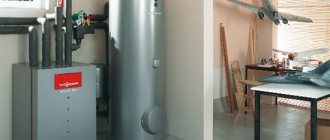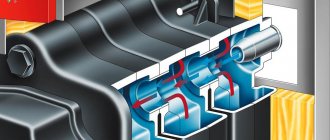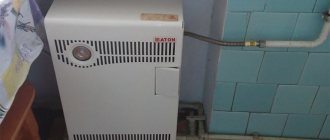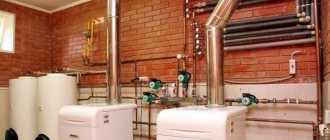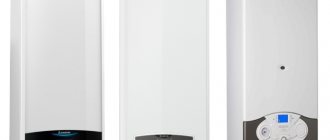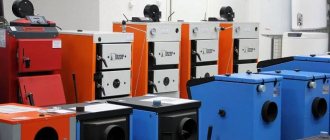Today, gas boilers are the best solution for heating almost any private house or apartment, both in terms of reliability and practicality, and in terms of purchase cost and operating costs.
Every year, one can more and more clearly observe a trend towards a preference for wall-mounted models: less universal, exclusively energy-dependent, but more efficient, compact and, in practice, according to statistics of service calls, almost as reliable.
In the article we will look at how to wisely choose an even more interesting option - double-circuit wall-mounted gas boilers, which allow, with the same size and efficiency, to provide the house with hot water.
Operating principle
Gas heating boilers are considered a practical and effective alternative to a central heating system, which is not available to all owners of private houses, and is sometimes simply expensive and unreliable. heating and hot water supply systems . In this case, one of the cheapest types of fuel will be used - natural gas (read: which gas is better for heating in a private home).
The installations differ in a number of indicators, but they all have a common operating principle. Using an automatic unit, gas enters the combustion chamber through the burner. Along the way, it mixes with air, enriching itself with oxygen. It burns in the chamber, and the heat released heats the coolant, which enters the heating system. Gas exhaust is discharged outside through the chimney.
Domestic gas boilers are classified according to the installation method, design features of the main elements, operating principle of the combustion chamber, purpose and power. When choosing a device, it is important to correctly assess the actual operating conditions, needs and your own capabilities.
We recommend reading: What is a double-circuit gas boiler and how does it work?
Controls, automation, protection levels
The boiler must be fairly easy to use, have clear controls, be equipped with the necessary functions to optimize operation and several degrees of protection against emergency circumstances.
Leading manufacturing companies are constantly improving their models, thereby creating competition between brands, so new developments are constantly appearing.
Thus, modern boilers can be equipped with the following options:
- Flame modulation in heating and water heating modes. The flame level is electronically regulated, ensuring smooth starts, which is especially important for models with instantaneous heating of DHW water. The automation independently selects the height of the flames depending on the set temperature and the specific current water flow. In some models, the last 5 degrees to the set heating temperature of the heating system are gained at a reduced combustion intensity. This allows you to make the operation of the device smoother, reduce the number of starts, and therefore increase the service life of the equipment.
- The smooth electronic ignition system pursues similar goals. When, after the minimum flame appears on the burners, it gradually grows to the specified combustion intensity within 30 - 40 seconds. When the boiler operates as a water heater, this option does not apply - what is important here, on the contrary, is the speed of heating the water to a given level.
- Weather-compensated boiler automation. This innovation, when installing an external street sensor, allows the equipment to monitor the level of external temperature and make adjustments to maintain an optimal microclimate in the apartment. More advanced equipment of this type also has an automatic self-adaptation function. Electronics not only compares graphs of changes in external and internal temperatures, but also conducts an analysis, making adjustments to the operation of the boiler, which leads to maximum comfort and significant gas savings.
- Pump post-circulation. A useful function that, when a room thermostat is installed, can significantly reduce energy consumption. Once the required heating temperature has been reached in the heating system, the boiler turns off and the pump continues to operate for another three minutes. When it is necessary to resume operation, both the boiler and the pump are started simultaneously.
- Naturally, all modern electronically controlled boilers allow you to accurately set the temperature in both the heating circuit and the DHW. In addition, some models provide two switchable ranges in heating mode - for conventional radiators and for heated floors.
- The electronics allow programming of the boiler operation for a certain period of time, with the programs being stored in memory for reuse.
- Any gas equipment has several degrees of protection - in case of insufficient draft, in case of heater extinguishing, in the absence or insufficient water pressure in the circuits, etc. In addition, modern models are equipped with other safety functions. So, if the temperature in the circuits drops to +5 degrees, the boiler will start on its own to bring the heating level of the coolant and water to a safe value, in order to avoid freezing. In addition, some control systems also monitor the condition of the boiler elements. If the device has not been used for more than a day, the processor will turn on the pump for a short time or switch the position of the three-way valve back and forth. This allows you to avoid blocking or “sticking” of these units and extends their service life.
- Control panels can have push-button, touch or electromechanical control, and are equipped with dial or digital indicators of temperature and pressure in the system.
Differences in installation method
Currently, two versions of domestic gas boilers are produced, differing in installation method:
Wall type
Such devices are compact and can be attached directly to the wall of the room.
They are quite light, and therefore do not create large loads, which allows their installation both on load-bearing structures and partitions.
In principle, a wall-mounted boiler can be mounted in any room, but to ensure safety, installation in residential premises (especially in bedrooms and children's rooms) is prohibited. The main disadvantage is their low power, which does not allow them to be used in large rooms.
Floor option
These boilers can have greater power and are installed in separate rooms equipped with reliable ventilation. The minimum area of the boiler room is 8 m² . The device is mounted on the floor, on a foundation or a special platform, at a distance of at least 50 cm from the wall.
Among floor-standing boilers, there are 2 types - devices with atmospheric burners with a power of up to 70 kW and installations with inflatable burners of increased power.
The choice of equipment according to the installation method is mainly determined by the size of the room and the availability of free space. Floor-standing models require the installation of a separate boiler room, but are able to provide heat to the entire house.
Features of mounted boilers
Wall-mounted boilers appeared as a type of heating device later than their floor-standing counterparts. This is due to the fact that it was necessary to minimize the main disadvantage of floor structures - significant dimensions and weight.
After extensive research and development, engineers came up with a compact, mounted version. As the name implies, this design is hung on the wall. Therefore, it is compact and light weight.
This is true. The main advantage of wall-mounted models is their weight up to 50 kg and convenient dimensions. Thanks to this, they can be placed in any non-residential premises; there is no need to equip a furnace room.
This is an advantage of mounted boilers, but also a significant drawback. Compact models cannot be powerful. On average, they can be used to heat a building with an area of no more than 100 square meters. m. Therefore, the devices are especially popular among apartment owners.
Another distinctive feature of mounted models is the complexity of the design. As a rule, the unit contains a pressurization system, expansion tank, circulation pump, automatic control, etc.
All this equipment constitutes a single system and is enclosed under the boiler body. On the one hand, this is very convenient, since it allows you not to think about problems with the arrangement of the circuit and its further operation.
The main feature of mounted boilers is their compactness and low weight with sufficient power. Thanks to this, they can be mounted on the wall
The device just needs to be turned on and configured, then it will work on its own. However, if it breaks down, and this may well happen, skilled and often expensive repairs will be required. What will become an additional expense item for the family budget.
It must be admitted that due to the complexity of the design and the presence of a large number of parts that can fail, the service life of wall-mounted models is shorter than that of floor-mounted models.
A mounted gas boiler requires proper piping. It is better to carry it out to specialists
Functionality
According to their capabilities, domestic gas boilers are divided into the following types:
- Single-circuit device . These boilers are only capable of providing heating. Their single-pipe design is simple and low cost.
- Double-circuit boilers . They have increased power and are capable, in addition to heating, of providing hot water supply, for which there is an appropriate hydraulic unit and a two-pipe system.
Both types of equipment are available in wall-mounted and floor-mounted versions. In the first case, the volume of the hot water tank is limited to 40-90 liters.
Manufacturers with a solid reputation
Among the many manufacturers, users and experts identify several brands that can really be trusted.
German company Vaillant
Presents high-quality heating equipment in a wide variety of designs. These are single- and double-circuit equipment of condensation and convection type.
The power of the units varies from 4 to 280 kW. The advantages of Vaillant include high-tech equipment, which makes its operation extremely simple and comfortable. The manufacturer cares about the highest level of safety of its products.
The units are equipped with gas supply control systems, auto diagnostics and a variety of types of protection. The equipment has high efficiency. For condensation models it is about 109%, for convection models – 94%. Vaillant boilers can operate on different types of gas, are environmentally friendly and very economical. For the convenience of consumers, the company has deployed a wide service network.
Gas boilers from Vaillant are equipped with the most modern protection systems
The general disadvantages of the equipment include the lack of necessary voltage stabilizers in the equipment package and rather expensive service. In some cases, it may not be entirely fast. Users highly rate Vaillant brand equipment and consider it excellent.
Brand Buderus from Germany
Represents several lines of heating devices. Wall-mounted Logamax plus – condensing units with power from 14 to 100 kW, Logamax – convection units from 7.8 to 35 kW. Floor equipment is available in two lines. Logano plus – condensing units with power from 16 to 1200 kW, convection Logano units from 20 to 1200 kW. The range of equipment is very wide and includes all known modifications.
Boilers from Buderus are characterized by high energy efficiency, high-quality automatic control, making operation easier. They can be built into the remote control system and can be controlled remotely. The devices combine well with other branded equipment, are equipped with effective sound and heat insulation, are highly environmentally friendly and cost-effective, and have an attractive appearance.
Buderus gas boilers are easily integrated into the Smart Home intelligent system. They can also be controlled remotely using a mobile device
Equipment from Buderus is reliable, high quality, economical, versatile and unpretentious. They rarely fail. Among the disadvantages, it is worth noting the completely plastic make-up taps and the lack of protection against possible power surges.
Italian brand Baxi
Produces a wide range of heating equipment. A distinctive feature of this equipment is the presence of a total protection system against a variety of threats: freezing and overheating of the coolant, lack of pressure, etc.
The devices are equipped with manual and electronic adjustment and control systems, highly informative LCD displays, and built-in automation capable of responding to weather changes.
Baxi boilers are economical and equipped with modulating burners. They can operate in two temperature ranges. The units are easy to install and convenient to use. Among the significant shortcomings, it is worth noting some capriciousness of the electronics and the possibility of incorrect operation of temperature sensors.
Zhukovsky Machine-Building Plant
The largest domestic manufacturer of high-quality heating gas equipment. There are three main lines of production: “Comfort”, “Beetle” and “Universal”, within which more than 30 models of boilers for various purposes are produced. Their advantages include improved automation, which has led to an increase in efficiency up to 89% and a decrease in the toxicity of flue gases.
Wall mounted boilers from Baksi fit perfectly into any interior. They are economical and safe to use
The equipment is capable of working with two types of gas, has non-volatile ignition, is equipped with overheating protection and gas mixture pressure control. The boilers are inexpensive and there are no problems with spare parts for them. Disadvantages include slight noise during operation of the equipment and low quality of manual welding carried out at the factory. Whereas there are no complaints about automatic.
Important advice. Don't skimp on quality. It is better to pay a little extra and purchase a device from a brand with a good reputation. It will last much longer than a fake of unknown quality, attractive only for its low cost.
We also recommend reading our article on how to install a wall-mounted boiler yourself.
Execution of combustion chambers
According to the design of the combustion chamber (combustion chamber), gas boilers are divided into the following types:
- Closed chamber. In such designs, a fan is installed to provide forced air supply to the combustion chamber, which improves the combustion process. The air duct has a coaxial design that allows exhaust gas to be removed. These boilers do not require chimneys. The safety of the system is increased by purging before gas combustion and after completion of the process.
- Open firebox . This classic option is much cheaper than the previous design, but requires a chimney. Its draft ensures the spontaneous supply of air and the removal of “working off”. The disadvantage of the device is reduced efficiency.
We recommend: How to gasify a private house
When choosing a cheaper model, you should take into account that increased requirements are imposed on the installation of chimneys. If the exhaust of gases from closed fireboxes can be installed even through a window, then the chimney must be vented to the roof.
Useful recommendations for choosing a quality device
Modern heating equipment has a beautiful design with all kinds of sensors and operating modes. However, you should choose not by the appearance of the boiler, but by its functionality. Some tips for choosing the optimal model:
- Material. Must be durable and thermally conductive. It is preferable to choose copper, it is more resistant to corrosion, is lightweight and has better heat transfer characteristics.
The efficiency of the unit depends on the conductivity of heat.
- Energy dependence. All mounted equipment operates on electricity. If it is turned off, the unit stops working. It is recommended to take care of a backup power generator in advance.
Do not forget to take into account such nuances as interruptions and surges in the electrical network.
- To organize individual heating in an apartment, it is better to install a boiler with an air blower and a coaxial pipe for exhaust gas outlet. It has simple installation and high efficiency.
These heating units are considered more practical and less troublesome. Air enters these units from the street using a turbine and a coaxial pipe.
For reference! It is not advisable to install heating equipment with an open chamber in living rooms.
Principles of gas combustion
In terms of how the fuel combustion process is ensured, gas boilers can have the following differences:
Convection boilers
This variety is considered traditional , and heating of the coolant in the boiler is provided only by the thermal energy released during fuel combustion.
The main advantages are low cost, simplicity of design and installation, compactness. The main disadvantages are insufficient efficiency and significant waste discharged into the chimney.
Condensing boilers
They use modern technologies, for which a special heat exchanger (water economizer) is installed. In this chamber, condensation of water vapor occurs, which in the conventional design of the apparatus carries unburnt gas into the chimney.
This system allows you to save up to 20 percent of fuel and increase efficiency by 1.7-2 times. The main disadvantage of boilers of this type is the high cost and additional energy consumption.
Currently, there is still a great demand for the first version of boilers for economic reasons and simplicity of design. However, it must be taken into account that the increased cost of condensing models quickly pays off due to gas savings.
Single-circuit and double-circuit floor-standing boilers
The basic function of any boiler is to heat the coolant for the heating circuit. All models have it, regardless of what additional capabilities they have.
There are units designed only for the preparation of coolant. These are single-circuit boilers that perform a single, main task. In addition, there are double-circuit boilers that can simultaneously prepare hot water for domestic needs while heating the heating agent.
They are equipped with an additional heat exchanger, which uses part of the excess thermal energy of the coolant.
These units are called dual-circuit. They allow you to get the maximum range of functions, but have some limitations in the performance of the DHW circuit.
Heating occurs in a flow mode, so it is not yet possible to achieve a uniform and stable temperature.
NOTE! Single-circuit boilers can be connected to external storage boilers. This will require some expenses, but as a result it makes it possible to obtain a stable and even hot water supply.
Pros and cons of gas equipment
To set up your own heating system, various types of boiler equipment are offered. What attracts people to gas equipment? The following advantages can be highlighted:
- Easy installation and use of standard components and fasteners.
- The ability to do most of the installation work yourself. Only starting up the equipment and inserting it into the gas main must be carried out with the participation of specialists with the appropriate approval.
- Sufficiently high efficiency. When using equipment of the required power, uniform heating can be ensured even in remote rooms.
- Saving money through the use of cheap fuel (natural gas).
- Ensuring safety through the availability of appropriate protective and monitoring devices.
- Possibility of process regulation and fuel consumption control.
- Insignificant impact on the environment.
- Compact equipment, even when using powerful devices.
- High reliability and long service life.
When choosing a system, you should also take into account the presence of certain disadvantages:
- long-term coordination of gas pipeline installation for the boiler room in various authorities;
- the need for a separate room for high-power boilers;
- the advantages of gas boilers are noticeable only when heating rooms with an area of more than 80-90 m².
In general, the advantages of gas boilers significantly outweigh all the disadvantages, which explains their demand in private housing construction and in suburban areas. The main condition is gasification of the territory, and at present, unfortunately, it does not cover all regions of the country.
More on the topic: Autonomous gasification of a private house
Step-by-step instructions for obtaining permission to install
We go to the local gas supplier, fill out and submit an application there for the installation of a gas boiler in the apartment. After some time, they must issue a conclusion on the technical feasibility of installing and connecting the boiler unit. Now it is necessary to obtain a conclusion about the proper state of ventilation. The address of the organization involved in checking ventilation ducts can be found in the fire inspection authorities or in the housing and communal services (you can usually find out the addresses of other necessary organizations here). If the ventilation is in order, we get a permit; if it does not meet the requirements, we get a conclusion on the required list of works, carry them out and again submit them for inspection to specialists who will issue a permit. We order a project from the local Gorgaz or any design bureau that has the right to carry out such work. At this stage, it is already necessary to decide on the model of the gas boiler and meter, since the project is drawn up in accordance with their technical characteristics. It is quite difficult to make changes to the project, and after it is signed, it is completely impossible (a new one is created). It is not necessary to buy a boiler and meter yet. We head to the local heating network and submit an application to refuse central heating (and, if necessary, hot water supply). You need to come here with a ready-made renovation project (installation of a gas boiler). You will also need: title documents for the apartment; technical certificate of the premises; written consent to disconnect all family members. We turn to gas workers (“Gorgaz”) and conclude an agreement for boiler maintenance. We also submit the project for approval; after its approval, you can carry out the installation of an individual heating system yourself or entrust the work to Gorgaz. At this stage, disconnection from the heating network is carried out, a boiler and gas meter are installed
Please note that the work is carried out outside the heating season, since it is necessary to drain water from the heating system of the entire house. The boiler is installed without connecting to the gas main. After completing all the work, you must contact Gorgaz to obtain an acceptance certificate for the conversion work
Gas workers will also connect the boiler to the gas main, carry out the adjustment and first start-up of the gas boiler, and put the appropriate stamp in the model passport (without this, the warranty on the boiler unit will be invalid).
What to look for when choosing?
When choosing a gas boiler for a private home, you need to pay special attention to the following characteristics:
- Power. This parameter is considered decisive when choosing equipment.
- Equipment dimensions. The dimensions of the boiler must be coordinated with the possibilities - the availability of free space and a separate room. If they are not available, you will have to build an extension to the house or a special building for the boiler room.
- The versatility of the device. If you need to provide hot water supply, you will have to think about a double-circuit option.
- Material. The durability and reliability of equipment largely depends on the material from which the structural elements are made. They should be dominated by parts made of stainless steel, bronze and brass. Reliable heat exchangers are made of cast iron, copper and stainless steel.
- Automation, protection and control. Boilers must be equipped with protection against flame extinction, gas leakage, loss of draft, overheating of the coolant, and electrical overloads.
- Quality and cost. It should be remembered that “the miser pays twice.” Savings when choosing gas equipment should be justified. You cannot buy very cheap devices offered by dubious sellers. It is best to choose well-known and proven models.
We recommend: Stages of gasification at home
Gas equipment can have various designs and modifications. It is important that it works for a long time, reliably and safely. When choosing it, you should carefully study the instructions, paying attention to the parameters and installation features.
We recommend reading: Where can I install a gas boiler in a private house?
Dimensions of wall-mounted gas boilers
A gas heating boiler is a device that uses fuel combustion (natural or liquefied gas) to heat the coolant.
Design (design) of a gas boiler
: burner, heat exchanger, thermally insulated housing, hydraulic unit, as well as safety and control devices. Such gas boilers require a chimney connection to remove combustion products. The chimney can be either ordinary vertical or coaxial (“pipe in pipe”) for boilers with a closed combustion chamber. Many modern boilers are equipped with built-in pumps for forced water circulation.
The principle of operation of a gas boiler
— the coolant, passing through the heat exchanger, heats up and then circulates through the heating system, releasing the resulting thermal energy through radiators, heated floors, heated towel rails, and also providing water heating in an indirect heating boiler (if it is connected to a gas boiler).
A heat exchanger is a metal container in which the coolant (water or antifreeze) is heated - can be made of steel, cast iron, copper, etc. The reliability and durability of a gas boiler depend primarily on the quality of the heat exchanger. Cast iron heat exchangers are resistant to corrosion and have a long service life, but are sensitive to sudden temperature changes and are heavy. Steel containers can suffer from rust, so their internal surfaces are protected with various anti-corrosion coatings to extend the “life” of the device. Steel heat exchangers are the most common in boiler production. Copper heat exchangers are not susceptible to corrosion, and due to their high heat transfer coefficient, low weight and dimensions, such heat exchangers are often used in wall-mounted boilers, but the downside is that they are more expensive than steel ones. In addition to the heat exchanger, an important part of gas boilers is the burner, which can be of various types: atmospheric or fan, single-stage or two-stage, with smooth modulation, double.
To control a gas boiler, automation is used with various settings and functions (for example, a weather-dependent control system), as well as devices for programming operation and remote control of the boiler.
The main technical characteristics of gas heating boilers are: power, number of heating circuits, fuel type, type of combustion chamber, type of burner, installation method, presence of a pump and expansion tank, automatic boiler control.
What is the best gas boiler to choose and how to choose by area? You can find out more in the article: How to choose a gas boiler.
To determine the required power
For a gas heating boiler for a private country house or apartment, a simple formula is used - 1 kW of boiler power to heat 10 m2 of a well-insulated room with a ceiling height of up to 3 m. If you need to heat a basement, a glassed-in winter garden, rooms with non-standard ceilings, etc. The power of the gas boiler must be increased. It is also necessary to increase the power (about 20-50%) when providing a gas boiler and hot water supply (especially if it is necessary to heat the water in the pool).
Feature of power calculation for gas boilers: the nominal gas pressure at which the boiler operates at 100% of the power declared by the manufacturer, for most boilers is from 13 to 20 mbar, and the actual pressure in gas networks in Russia can be 10 mbar, and sometimes lower . Accordingly, a gas boiler often operates at only 2/3 of its capacity and this must be taken into account when calculating. More details on the table for calculating the power of a heating boiler can be found here
Most gas boilers can be converted from natural gas to liquefied gas
(cylindered propane). Many models switch to liquefied gas at the factory (when purchasing, check these characteristics of the model), or the gas boiler is additionally supplied with nozzles (nozzles) for switching to bottled gas.
Pros and cons of gas boilers:
Gas boilers are the best choice if you have mains gas or liquefied gas.
(+) low cost of use (+) economical (+) ease of operation (+) high power (+) compact size (+) popularity (+) many options for manufacturers and costs
(-) the need for constant availability of gas and its sufficient pressure (-) strict requirements for installation (-) the need to obtain permission for installation (-) constant monitoring of gas leaks (-) the need for professional connection and maintenance (-) certain requirements for the premises, where is the boiler installed
The heating boiler can have one (for heating only) or two circuits (heating and hot water supply (DHW)). An external boiler can be connected to a single-circuit boiler to provide hot water (from 100 to 3000 liters at the buyer’s choice, the best option for large hot water consumption or with several water collection points). You can also pay attention to boilers with a built-in boiler. Of course, they are larger in size and weight than regular ones, and in some cases their maintainability is lower, like any other device that combines two devices, but sometimes this is the best option to provide both heat and water at once.
The most economical boilers are condensing boilers. Thanks to the use of modern technologies, the efficiency of such boilers is 10-11% than that of conventional ones. Operating principle of a condensing boiler
: When gas is burned, combustion products are formed, which contain a large amount of steam. When steam condenses, it releases a certain amount of heat, which can also be used to heat the coolant. Steam condensation occurs in a special heat exchanger of increased area, which supplies additional heat to the heating system. The advantages of condensing boilers are exceptional efficiency and cost-effectiveness compared to conventional ones, the disadvantages are the high price and the need for constant removal of condensate that forms in the heat exchanger.
Gas boilers by installation method
can be floor-mounted or wall-mounted (mounted). Wall-mounted boilers most often have small power and dimensions, while high-power industrial boilers are floor-standing, have large dimensions and are installed in large-area boiler rooms.
Boiler connection
is carried out in accordance with the installation and operating instructions supplied with it. Each gas boiler option has its own installation features in a specific location. To correctly install and connect a gas heating boiler, you must contact professional installers who are certified to work with gas equipment.
Requirements for the premises, norms and rules for installing a gas boiler
: For gas equipment, strict requirements are imposed both on the room where it will be installed, and on the equipment itself and the installation method. You can read more about this topic here: Rules and requirements for installing gas boilers
Boiler piping
- These are devices for the full operation of the heating and water supply system. It includes: pumps, expansion tanks, filters (if necessary), manifolds, check and safety valves, air valves, valves, etc. You will also need to purchase radiators, connecting pipes and valves, thermostats, a boiler, etc. The issue of choosing a boiler is quite serious, so it is better to entrust the selection of equipment and its complete set to professionals.
Which boiler is the best? The Russian market of gas boiler equipment has its own leaders in quality and reliability. The best manufacturers and brands of gas boilers are presented in the assortment:
“Premium class” or “Lux” are the most reliable and durable, easy to use, the kit is assembled like a “construction set”, more expensive than others. Such manufacturers include the German companies Buderus and Viessmann.
“Middle class” - good performance, average price, not so prestigious, but quite reliable, standard standard solutions are presented. These are Italian boilers Ariston, Hermann and Baxi, Swedish Electrolux, German Unitherm and boilers from Slovakia Protherm.
"Economy class" - budget simple gas boilers, service life is shorter than that of boilers of a higher category. Some manufacturers have budget models of gas boilers, for example, Ferroli or Neva Lux. Domestic gas boilers and boilers of imported brands, but Russian production (assembly) are distinguished by affordable prices and high maintainability.
See also:
- How to choose a gas boiler
- All gas boilers
- Gas boilers AOGV
- Boilers for heating boilers
- Automation for heating boilers
- Double-circuit boilers
- Single-circuit boilers
- Floor standing boilers
- Wall boilers
Need help choosing or haven't found the model you're looking for?
Call!
Power calculation
The power of a gas boiler is considered the main determining parameter, and therefore it is very important to evaluate it correctly. A simple approach is usually used - in rooms up to 2.8 m high, the power is selected at the rate of 1 kW for every 10 m² of area with a margin of 12-15 percent for unexpected heat losses.
If the house is located in an area where severe frosts are common, and the structure is not insulated enough, then another 22-26 percent of the reserve should be added.
It is customary to carry out such an assessment. A gas boiler with a power of 10-15 kW is capable of heating no more than 2 rooms. Equipment of 36-42 kW will provide heat to a house with an area of up to 180-200 m².
When arranging hot water supply, you should take into account the composition of the family. So for two people you need a capacity of 10-11 l/min. For a family of 4 people, 14-16 l/min will be required, which requires a boiler with a capacity of 22-25 kW. 40 kW boilers produce hot water at a speed of 20-22 l/min.
Room standards for a boiler with a closed firebox
The regulatory requirements for installing a gas unit with a closed firebox are not so demanding. This is due to the reliable smoke exhaust system of these modifications.
Scheme with a closed firebox
In them, exhaust boiler gases are removed from a closed combustion space into a coaxial pipe. Through it, directly from the street, a forced supply of fresh air is performed to ensure complete combustion of the fuel.
In this regard, modifications of boilers with a power of up to 60 kW can be installed in any non-residential premises that meet the following requirements:
- The height of the room is not lower than 2.2 m;
- total volume - over 7.5 m3;
- reliable supply ventilation;
- walls and floors made of durable fire-hazardous materials.
Selection of manufacturer and model
It is better to choose gas boilers taking into account the manufacturer, who is able to guarantee high quality. The following well-known foreign companies can be distinguished:
- Navien and Kiturami (South Korea);
- Ariston and Baxi (Italy);
- Buderus, Vaillant, Viessmann and Bosch (Germany);
- Protherm (Slovenia).
Among Russian manufacturers, Irbis and Titan stand out.
Among specific models, the following brands deserve special attention:
- BAXI SLIM 1.490 iN (Italy). This is a single-circuit device capable of heating up to 370 m². Has a cast iron heat exchanger. Efficiency reaches 90 percent.
- Protherm Medved 50 KLZ (Czech Republic). Single-circuit boiler with a power of 50 kW. Equipped with a 110 liter hot water boiler.
- Buderus Logano G334WS-73 (Germany). This is a single-circuit floor-standing boiler with a power of 73 kW. Capable of heating a house with an area of about 650 m².
- Vaillant AtmoVit INT 164-564/15 (Germany) single-circuit, floor-standing device. Power is 15.8 kW. Can heat a room up to 280 m².
- Alpine Air FL-8 (Italy). Designed for small auxiliary premises with an area of up to 45 m². It is characterized by its small size and low gas consumption.
- Kusaterm 10-20. It is most often used for baths and saunas. The design includes a fan for forced circulation of heated air.
- Buderus Logano G125-32WS (Germany). Double-circuit boiler with a power of 125 kW. Efficiency reaches 95 percent.
- Baxi SLIM 2.230 (Italy). This is a double-circuit gas boiler with a power of 22.1 kW. Hot water supply – up to 12 l/min.
- Bosch Gaz 6000 WBN-24CRN (Germany). This boiler is considered one of the best wall-mounted structures. Gas consumption - 2.6 m³.
- Protherm Panther 12 KTZ (Slovenia). It is considered a very economical model. Capable of heating a room of 88 m². Power – 11.6 kW.
- NAVIEN DELUXE 24K (South Korea). It is a double-circuit boiler for heating a room up to 250 m² and supplying hot water with a capacity of 14 l/min.
Scope and characteristics of boilers
As a rule, a floor-standing gas heating boiler is installed in large cottages. The average size of the area for which such units are enough to heat is 500 square meters. m, and the power is about 50–70 kW (maximum power value is 1000 kW).
The efficiency of the equipment is quite high - usually at least 90%. Weight can reach 150 kg - floor-standing gas boilers are among the heaviest heating devices.
Such boilers are usually purchased from online services, where there is a good selection and affordable prices. In addition, if you contact TeplovodService to purchase a floor-standing gas boiler (Baxi, Navien or other well-known manufacturers of which our company is a dealer), then here you will also find an official two-year guarantee and delivery of the boiler on the day of purchase .
The cost of a boiler for a private house
The cost of domestic gas boilers depends on their power, type and additional elements. It varies widely from 240 to 1200 US dollars. Small wall-mounted devices from well-known foreign companies can be purchased for 20-25 thousand rubles.
Double-circuit modifications start from 28-30 thousand rubles. Condensing type boilers will be somewhat more expensive. So the Baxi Power 1.450 device costs 145 thousand rubles.
Gas boilers provide reliable heating and, if necessary, hot water supply in a private home. When choosing equipment, it is necessary to take into account the basic parameters and operating conditions. These devices, when properly installed and used correctly, are completely safe and have a significant service life.
General information about boilers, their placement
Their entry into the body causes disturbances in human life processes. In large doses, the compounds provoke the development of dangerous diseases. Don’t forget about natural gas itself: it is explosive and requires special handling when used.
In private homes, various gas boilers are used, which have different air exchange requirements. For high-power floor-mounted equipment, placement requirements have been established. Such units can be installed in a separate special building, in an extension to the main house, in the attic, basement or basement.
Additional requirements apply to objects where a floor-standing gas boiler is located:
- Area of at least 4 sq. m.
- The volume of the room is at least 8 cubic meters. m.
- The ceiling height is at least 2.2 m.
- The width of the entrance opening is at least 80 cm.
- The presence of at least one window with direct access to the air with opening doors for ventilation.
- The presence of an open air supply is a gap in a wall or window profile through which oxygen constantly flows.
- Since the object is classified as explosive, the glazing area in it must exceed 0.05 square meters. m per 1 cubic meter m. room volume.
The use of a basement and plinth is allowed with restrictions, subject to a number of additional requirements. In such premises, it is necessary to equip the main and backup ventilation systems, since disruption of the air exchange structure will lead to the threat of explosion.
Most often, wall-mounted boilers of low power are used. The average power of such heating units is 30 kW. They are provided with a productive and convenient internal combustion chamber. This equipment is subject to less stringent placement requirements. Wall-mounted boilers can be placed in the utility room, kitchen or bathroom.
A wall-mounted gas boiler can be placed in the kitchen
- Delivery of the volumes of oxygen required for the direct combustion process. If there is insufficient supply of fresh air, combustion provokes the release of excessive amounts of dangerous compounds.
- Optimal conditions are created for efficient operation of equipment.
- Removal of combustion products and the gas itself from the premises in case of equipment malfunction.
Classification of ventilation systems that are used in most private houses:
- According to the principle of creating traction: natural or forced.
- In the direction of movement: supply, exhaust, combined (coaxial).
- By design: channel or integral, without channels.
Factors influencing the parameters of the air exchange system in a room with a gas boiler:
- The power of the device, its functional features.
- Room area.
- Load on the boiler (frequency of use).
- Availability of windows and doors.
- Features of the climate of the area where the house is located (temperature, wind, precipitation, humidity, etc.).
There are several factors that influence the parameters of the air exchange system in a room with a gas boiler
Requirements for the chimney device
The safety of a gas boiler is directly related to the correct installation of the smoke ventilation system, which must exhaust all exhaust gases into the atmosphere.
The following requirements apply to chimney installation:
- The chimney should not have more than 3 turns.
- The diameter of the flue must match the size specified by the boiler manufacturer.
- The edge of the pipe is placed 500 mm above the roof ridge.
- The hole for the passage of the chimney through the building structures of the task is made larger than the diameter of the pipe, the gaps between them are filled with fireproof material, especially in the area of wooden nodes.
- The smoke exhaust system must have a condensate drain at the bottom of the pipe and a deflector at the top.
Boiler room volume for different boilers
If the total heat generation is up to 30 kW, then it is required to install the boiler in a room of at least 7.5 m3. We are talking about combining the boiler room with the kitchen or integrating it into the home space. If the device emits from 30 to 60 kW of heat, then the minimum volume level is 13.5 m3. It is allowed to use extensions or separate areas on any level of the building. Finally, if the device power exceeds 60 kW but is limited to 200 kW, then a minimum of 15 m3 of free space is required.
In the latter case, the boiler room is located at the owner’s choice, taking into account engineering recommendations in:
- extension;
- any of the rooms on the first floor;
- autonomous structure;
- plinth;
- dungeon.

